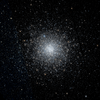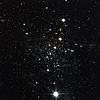Shapley–Sawyer Concentration Class
The Shapley–Sawyer Concentration Class is a classification system on a scale of one to twelve using Roman numerals for globular clusters according to their concentration. The most highly concentrated clusters such as M75 are classified as Class I, with successively diminishing concentrations ranging to Class XII, such as Palomar 12. (The class is sometimes given with numbers [Class 1–12] rather than with Roman numerals.)
History[edit]
From 1927–1929, Harlow Shapley and Helen Sawyer Hogg began categorizing clusters according to the degree of concentration the system has toward the core using this scale. This became known as the Shapley–Sawyer Concentration Class.[1]
Classes[edit]
| Class | Description | Example |
|---|---|---|
| I | High concentration toward the center |  |
| II | Dense central concentration |  |
| III | Strong inner core of stars |  |
| IV | Intermediate rich concentrations |  |
| V | Intermediate concentrations |  |
| VI | Intermediate mild concentration |  |
| VII | Intermediate loose concentration |  |
| VIII | Rather loosely concentrated towards the center |  |
| IX | Loose towards the center |  |
| X | Loose |  |
| XI | Very loose towards the center |  |
| XII | Almost no concentration towards the center |  |
References[edit]
- ^ Hogg, Helen Battles Sawyer (October 1965). "Harlow Shapley and Globular Clusters". Publications of the Astronomical Society of the Pacific. 77 (458): 336–46. Bibcode:1965PASP...77..336S. doi:10.1086/128229. JSTOR 40674226.
- ^ Burton, Jeff (July 26, 2011). "Shapley–Sawyer Globular Cluster Concentration Class". Archived from the original on March 22, 2012.
